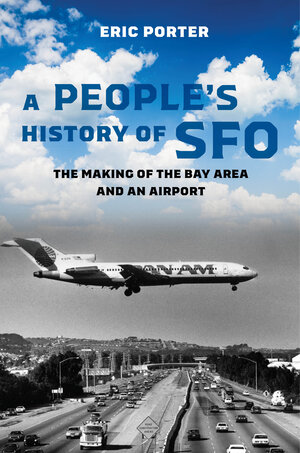By Eric Porter, author of A People’s History of SFO: The Making of the Bay Area and an Airport
For many people, airports may seem like alienating “nonplaces”—as anthropologist Marc Augé put it—where we rush to make connections and spend long, monotonous hours waiting for delayed flights. But I’ve long seen airports as fascinating sites that can tell us a lot about where they are situated.
Take the simple scenes of service work at airports and the lessons they provide about regional social dynamics. I recall how the large number of white people working the fast-food counters at Sea-Tac in the early 1990s showed me the declining fortunes of that working class in the area. A decade later, a white woman purposefully tossing trash at the feet of a veiled, Somali custodial worker at Phoenix Sky Harbor made clear rising Islamophobia, the changing face of anti-Blackness, and the challenges facing East African immigrants in the region after 9/11.
My own family history with SFO is also a part of this larger story. My grandfather worked as a skycap there beginning in the 1940s. Carrying white people’s luggage and the racial baggage that came with it was servile but good-paying work. My grandfather used it to secure some measure of geographic and social mobility for himself and his family, as they left the South and relocated to the Bay Area during the Second Great Migration.
As I’ve come to learn, airports are complexly networked infrastructures. Their operations have drawn together and been shaped by the interactions among various groups of humans (e.g., travelers, workers, and government officials); municipal, state, and federal laws and regulations; economic flows of different scales; built urban, suburban, and exurban environments; and natural phenomena such as the wind patterns that determine the orientation of runways. In other words, airports have long facilitated shifting, often-unexpected, and usually asymmetrical entanglements among multiple systems, relations, and structures—at once locally oriented and far reaching.
By focusing on such entanglements, my new book A People’s History of SFO tells the story of one airport as an infrastructural manifestation of accumulated colonial and imperial power in the Bay Area — and a production site for new forms of power in the present. Covering phenomena ranging from SFO-based Black labor and antidiscrimination struggles to anti-jet noise activism in surrounding communities to the airport’s own public art, museum, and sustainability programs, I also illustrate how unequal relationships visible at the airport extend well beyond the facility itself. In fact, the story of SFO helps us understand how differently positioned people in the region have abided, resisted, and otherwise negotiated the powerful forces that have shaped their lives.
This is also a study that reaches beyond the region, as it tells a larger story of colonialism’s and empire’s legacies, emergences, and futures as lived within their North American, metropolitan laboratories. I hope after picking up the book, readers will find themselves looking at airports a bit differently on their next time passing through.



